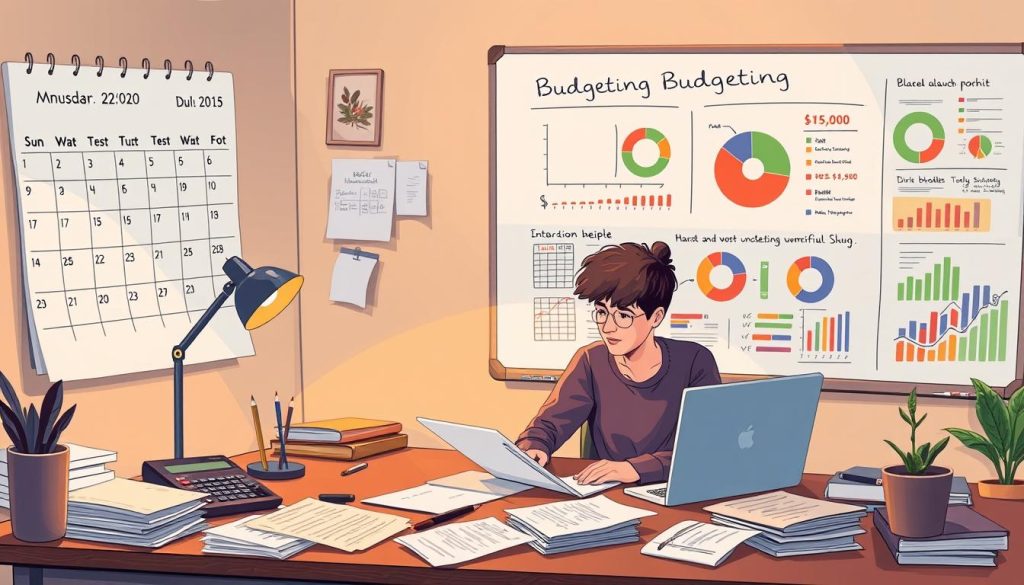Avoid Common Education Loan Mistakes: Smart Borrowing
Understanding education financing can be tough. But, with the right info, you can make smart choices for your future. This article will help you navigate the world of education loans. You’ll learn about federal and private loans, and other ways to fund your education.
Key Takeaways
- Learn the differences between federal and private loans. This includes interest rates, repayment terms, and who can get them.
- See how loans can affect your credit score. Find ways to keep your credit healthy.
- Know about repayment plans, penalties for early payment, and income-driven plans. This helps you borrow responsibly.
- Look into other funding options like scholarships, grants, and state loans. This can reduce your loan needs.
- Get a full grasp of the loan application process. Know the deadlines and what documents you need to avoid mistakes.
Understanding the Basics of Education Loans
Exploring education financing can seem overwhelming. But knowing the difference between federal and private loans is key. Federal loans, like Direct Subsidized and Unsubsidized Loans, have fixed interest rates and flexible repayment plans. This makes them a top pick for many students. On the other hand, private loans have variable interest rates and may check your credit score.
Loan Comparison: Federal vs. Private
When looking at federal vs. private loans, focus on interest rates, repayment plans, and loan terms. Federal loans usually have lower rates and flexible repayment options. Private loans might have higher rates but offer more flexibility in loan amounts and repayment times.
Credit Score Impact and Loan Terms
Getting education loans can greatly affect your credit score. Private lenders often do hard credit checks, which can lower your score temporarily. It’s also important to understand the loan terms, like repayment periods and any fees. This ensures you make a choice that fits your financial plans.
“Researching and understanding the differences between federal and private education loans can help you make the best decision for your financial future.”
Common Mistakes When Taking Out Education Loans: How to Avoid Them
Getting an education loan can be tough. Even those who mean well can make mistakes. These errors can affect you for a long time. We’ll look at the most common mistakes and give tips to avoid them.
One big worry is loan default. This happens when you can’t pay on time. It’s often because you didn’t think about the real cost of school or faced unexpected money problems. To avoid this, make a solid plan for how much you can borrow. Think about your future income and school costs.
Another mistake is using a cosigner. A cosigner can help you get a loan, but they take big risks. If you can’t pay, they have to. This can hurt their credit and money situation a lot.
- Look into different lenders to find the best deal.
- Don’t borrow more than you need. Think about your money situation and other ways to pay for school.
- Watch out for mistakes in your loan application. These can slow down or stop your loan.
- Make a good budget to handle your loan payments.
By being careful and making smart choices, you can handle education loans well. This way, you can reach your academic goals without hurting your money future.
“The key to successful borrowing is to approach it with a clear plan and a keen understanding of the potential risks and responsibilities.”
Responsible Borrowing Strategies
Understanding education loans can be tough. But, with smart borrowing, you can lessen the financial load. It’s key to budget for loans and know your repayment schedule.
Budgeting for Loans and Repayment Timeline
When you borrow for school, making a budget is crucial. Include your monthly payments, interest, and grace periods. This helps you see what you owe and manage your payments better.
Also, learn about your loan repayment options. Federal and private loans offer different plans like standard or income-driven. Knowing these can help you choose the best repayment plan for you.
Exploring Alternative Funding Sources
Loans are often needed for school, but look for other funding too. Scholarships, grants, and state loans can help without needing to be paid back. Applying for these scholarship alternatives and funding sources can lessen your loan burden. Plus, loan forgiveness programs might help even more.
| Funding Source | Key Considerations |
|---|---|
| Scholarships | Eligibility criteria, application deadlines, and award amounts can vary widely. |
| State-specific loans | Explore state-specific loan programs that may offer more favorable terms and financial aid options. |
| Grants | Research federal, state, and institutional grants based on financial need or academic merit. |
By budgeting for loans, understanding repayment, and finding other funding, you can handle education loans well. This approach will help you financially succeed in the long run.

Navigating the Repayment Process
Starting your journey to pay off education loans can feel overwhelming. But, with the right approach, you can tackle it confidently. It’s important to know about the different repayment plans out there. This includes the popular income-driven repayment options.
Income-Driven Repayment Plans
Income-driven repayment plans adjust your monthly payments based on your discretionary income. This can make your payments more affordable, helping you manage your finances better. You can then focus on paying off your loans while still meeting other financial needs. Some common plans include:
- Income-Based Repayment (IBR)
- Income-Contingent Repayment (ICR)
- Pay As You Earn (PAYE)
- Revised Pay As You Earn (REPAYE)
To ensure a smooth repayment process, knowing your loan servicer responsibilities is key. Your loan servicer handles your loan account, makes payments, and offers guidance. Understanding their role and your duties can help you avoid prepayment penalties and other issues.
| Repayment Plan | Monthly Payment | Loan Forgiveness |
|---|---|---|
| Income-Based Repayment (IBR) | 10-15% of discretionary income | Remaining balance forgiven after 20-25 years |
| Income-Contingent Repayment (ICR) | 20% of discretionary income | Remaining balance forgiven after 25 years |
| Pay As You Earn (PAYE) | 10% of discretionary income | Remaining balance forgiven after 20 years |
| Revised Pay As You Earn (REPAYE) | 10% of discretionary income | Remaining balance forgiven after 20-25 years |
By understanding the repayment process and the options available, you can make smart choices. This helps you develop a plan to manage your education loans effectively.

Conclusion
Understanding your education loans is key when you’re in college. Knowing about federal and private loans helps you make smart choices. This knowledge is important for your financial future.
It’s also vital to plan your loan payments carefully. Think about your income and lifestyle after graduation. Looking into scholarships and grants can lessen your loan needs. This can make your financial journey easier.
Managing your loans might seem tough, but there are ways to make it work. You can consolidate loans or use income-driven plans. By keeping an eye on your finances, you can overcome student loan challenges. This will help you reach your goals with confidence.
FAQ
What are the key differences between federal and private education loans?
Federal loans often have more flexible repayment plans and lower interest rates. They also offer loan forgiveness options. Private loans, on the other hand, might have higher rates but can help if you’ve reached your federal loan limit.
How can education loans impact my credit score?
Education loans can affect your credit score in several ways. They can increase your debt-to-income ratio and impact your payment history. If you default, it can lead to derogatory marks. Managing your loans well is key to keeping a good credit score.
What is the repayment timeline for education loans, and are there any penalties for early repayment?
The repayment time for education loans varies, usually between 10 to 25 years. It depends on the loan type and plan. Some lenders might charge penalties for early repayment. Always check the loan terms carefully.
What are some alternatives to traditional education loans?
Instead of loans, consider scholarships, grants, work-study programs, and state-specific loans. Looking into these options can help reduce your need for loans. This can also lower the debt you’ll have after graduation.
How do I choose the right lender and loan program?
When picking a lender and loan, look at interest rates, repayment terms, and fees. Also, consider customer service. Research the lender’s reputation and read reviews. Comparing offers from different providers is crucial to find the best deal.
What is the difference between an income-driven repayment plan and a standard repayment plan?
Income-driven plans adjust your payments based on your income. They’re more affordable for those with lower incomes. Standard plans have fixed payments over 10 years. Your choice depends on your financial situation and goals.
How can I avoid common mistakes when applying for and managing education loans?
To avoid mistakes, carefully review your loan application and only borrow what you need. Avoid cosigning for others and stay on top of payments to avoid default. Keeping a budget and understanding your loan terms can help manage your debt effectively.






